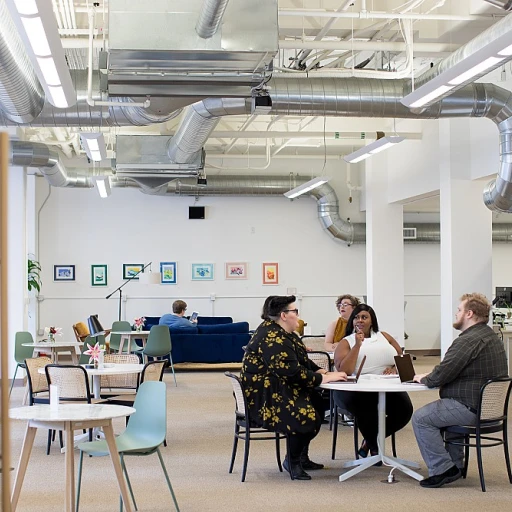The Role of AI in Workforce Development
The Influence of AI on Employee Progression
Artificial intelligence is playing an increasingly crucial role in workforce development, transforming the way organizations approach training and growth. As technology advances, AI-driven tools help businesses enhance employee skills and improve their transition into new roles by offering tailored training programs. This has significant implications for workforce progression, as AI enables a more personalized learning experience, adapting to each employee's skills and career aspirations.
With the integration of AI, training programs are now more efficient, allowing employees to quickly acquire new skills crucial for their roles. This not only increases job satisfaction but also improves the overall efficiency of operations within the organization. It's essential that businesses consider potential downsides to this evolution, such as technology overdependence, to ensure a balanced approach towards workforce planning.
The landscape of employee training is further enhanced by AI through the provision of custom learning paths and intelligent recommendations, paving the way for professional development. For those contemplating new career opportunities or enhancing their current skill set, programs with intelligent orientation control offer a personalized and efficient way to navigate career pathways, ushering in a new era of employee engagement and workforce development.
Potential Downsides to Workforce Development
Challenges in Workforce Training and Development
As organizations increasingly adopt AI-driven HR practices, it's essential to consider the potential downsides to workforce development. While AI can streamline processes and enhance efficiency, it also presents challenges that need addressing to ensure a balanced and effective work environment.
Impact on Job Training and Employee Skills
One significant concern is the potential mismatch between current employee skills and the demands of AI-integrated roles. As AI technology evolves, so must the skills of the workforce. This requires continuous training programs and employee training initiatives to bridge the gap. However, not all organizations have the resources to invest in comprehensive training, which can lead to skill shortages and impact job satisfaction.
Adapting to a Changing Labor Market
The integration of AI in HR can also disrupt the labor market, affecting employment patterns. AI can automate tasks traditionally performed by humans, leading to concerns about job displacement. While AI can create new roles, the transition period may cause uncertainty among workers, particularly those lacking access to higher education or community college programs.
Organizational Culture and Employee Morale
AI's role in HR can influence the culture within an organization. The focus on technology might overshadow the human aspect of HR, affecting employee morale and job satisfaction. Balancing AI integration with a personal touch is crucial to maintaining a supportive work environment. Companies need to foster an inclusive culture that values both technological advancements and human contributions.
Time and Resource Constraints
Implementing AI-driven HR solutions requires time and resources. Organizations must allocate sufficient resources for workforce planning and professional development to ensure a smooth transition. Short-term costs might be high, but the long-term benefits of a well-trained and adaptable workforce can outweigh initial investments.
For more insights into how AI is reshaping HR roles and career opportunities, explore the career opportunities with AI's role in HR.
Ethical Concerns in AI-Driven HR Practices
Ethical Implications in AI Technologies within HR
Artificial Intelligence is revolutionizing workforce development, offering unprecedented benefits in job training and employee training programs. However, the surge of AI in HR has raised several ethical concerns that organizations must address. Companies leveraging AI-driven systems must ensure that their training programs and workforce development strategies are transparent and aligned with fair employment practices. Bias remains a significant concern when AI tools are used for workforce planning and performance assessments. If unchecked, these biases could lead to unwarranted discrimination in job promotions, hiring, or even workforce reduction, ultimately affecting job satisfaction and organizational culture. The protection of employee data is another ethical challenge. AI systems collect vast amounts of information to personalize learning and development programs. However, safeguarding this data has become critical for maintaining trust within the labor force, securing employee privacy, and ensuring compliance with data protection regulations. Moreover, there's a growing concern about the potential loss of the human element in HR processes. While AI brings efficiency, organizations must strive to balance technology with the human touch to foster a supportive work environment and enhance job satisfaction. Incorporating AI-driven training solutions without ignoring human oversight might be essential for sustained ethical compliance. A blend of AI's analytical power with human intuition can ensure fairness in workforce planning and long-term professional development. For those looking to refine their approaches, integrating tools and policies that emphasize ethical AI practices is vital. Consider exploring resources that discuss enhancing managerial skills with AI to gain insight into ethical AI integration.Balancing Technology and Human Touch
Finding the Right Balance: Merging Technology with Human Insight
Achieving a harmonious integration of AI in workforce development demands careful consideration of both technological advancements and the intrinsic human qualities that define the workforce. It's imperative to remember that while AI can process vast amounts of data efficiently, it lacks the emotional intelligence that comes naturally to humans. Therefore, emphasizing a balance between digital and personal interactions becomes key. The strength of AI lies in its ability to efficiently streamline tasks such as job training and workforce planning. It supports organizations in recognizing skill gaps, tailoring employee training programs, and predicting labor market trends. However, human oversight remains crucial to interpret and implement AI insights effectively. Businesses must foster a culture where technology complements rather than overrides human decisions. This requires an environment that encourages continuous learning and personal development among employees. These efforts must not only focus on current needs. Organizations should also anticipate future trends in workforce development by adjusting their training programs and strategies accordingly. High schools, community colleges, and higher education institutions play a vital role in equipping the new global workforce, ensuring long-term sustainability and job satisfaction for employees within the labor force. Finally, the combination of AI-driven insights and human expertise can lead to enriched professional development. Employers need to support their staff by creating opportunities that cater to the diverse education backgrounds and training needs of their employees. By doing so, businesses can ensure that both short-term goals and long-term objectives are met, ultimately leading to improved performance and engagement in job roles.Case Studies: Real-World Examples
Learning from Real-World Implementations
In order to illustrate how AI-driven HR practices are being applied successfully in various sectors, it's essential to explore real-world examples that provide insight and inspire innovations in workforce development. These cases highlight how organizations have integrated AI solutions, while also demonstrating the importance of balancing technology with the human touch to maintain job satisfaction and a supportive work culture. One prominent example is the integration of AI-powered professional development platforms in large commercial organizations. Here, AI tools aid in assessing current employee skills and recommending personalized training programs tailored to enhance competencies for long-term growth. Community colleges have also adopted similar AI-based solutions, offering targeted training programs that align closely with the ever-evolving demands of the global workforce. By focusing on specific skills required in the labor market, these institutions help bridge the gap between education and employment. Moreover, some organizations have successfully utilized AI to streamline workforce planning and employee training efforts, ensuring that both short-term achievements and long-term objectives are met. For instance, by using AI analytics, businesses can predict labor force trends and adjust their workforce training initiatives to mitigate potential skill shortages. This proactive approach not only supports the organization but also aids in professional and personal development for individual employees. Another inspiring example comes from the healthcare sector, where AI-driven platforms have been instrumental in enhancing job training for medical staff. These initiatives support staff by improving training efficiency and ensuring continuous professional development, thus aligning with the critical responsibilities that medical workers hold in providing quality patient care. These case studies reveal the potential for AI technologies to contribute positively when integrated thoughtfully into workforce development strategies. They underline the importance of understanding both the pros and cons of AI adoption, as well as ensuring that ethical practices guide these technological advancements. As organizations continue to evolve with AI-driven solutions, it is evident that fostering a balanced and inclusive work environment remains paramount for successful implementation.Future Outlook: Preparing for AI in HR
Preparing Organizations for an AI-Driven Future
As artificial intelligence continues to reshape the landscape of human resources, organizations must proactively prepare for the inevitable changes. Workforce development will play a crucial role in this transformation, ensuring employees are equipped with the necessary skills to thrive in an AI-enhanced environment.
Investing in Continuous Learning
One of the key strategies for preparing for AI in HR is investing in continuous learning and development programs. Training employees through community colleges and other educational institutions can help bridge skill gaps and enhance job satisfaction. These programs should focus on both technical skills and soft skills, ensuring a well-rounded workforce.
Emphasizing Workforce Planning
Effective workforce planning is essential to align organizational goals with the capabilities of the labor force. By understanding the pros and cons of AI integration, HR leaders can make informed decisions that balance technology with the human touch. This approach helps maintain a positive work culture and supports long-term organizational growth.
Fostering a Culture of Adaptability
Creating a culture that embraces change and encourages personal development is vital for the successful integration of AI in HR. Organizations should promote a mindset of adaptability, where employees are encouraged to engage in professional development and explore new opportunities within the labor market.
Collaborating with Educational Institutions
Partnering with higher education institutions and community colleges can provide valuable resources for job training and workforce development. These collaborations can help tailor training programs to meet the specific needs of the organization and the global workforce, ensuring employees are well-prepared for future challenges.
Preparing for the Long-Term
While the short-term benefits of AI in HR are evident, organizations must also consider the long-term implications. By fostering a culture of continuous learning and adaptability, companies can ensure their staff is ready to navigate the evolving landscape of employment services and workforce development.












